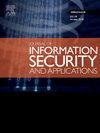A feature vector-based modeling attack method on symmetrical obfuscated interconnection PUF
IF 3.7
2区 计算机科学
Q2 COMPUTER SCIENCE, INFORMATION SYSTEMS
Journal of Information Security and Applications
Pub Date : 2025-08-16
DOI:10.1016/j.jisa.2025.104187
引用次数: 0
Abstract
Physical unclonable function (PUF) are widely used in solutions such as device authentication and lightweight encryption due to their tamper-resistant, key-free storage and lightweight properties. However, the security of PUFs is threatened by modeling attacks. In this paper, we propose a novel modeling attack method for the symmetrical obfuscated interconnection physical unclonable function (SOI PUF) based on feature vectors. The proposed method introduces an innovative feature vector transformation technique and vector response pair to capture higher-order relationships with complex PUF architectures. Meanwhile, we propose two important principles for designing deep neural network (DNN) attack models. The experiments are systematically validated for the novel SOI PUF and cSOI PUF architectures, and the results show that, under equivalent dataset conditions, the proposed method achieves a higher attack success rate compared to the traditional challenge-response pair-based modeling approaches, achieving an accuracy of 98.42% in modeling SOI PUF. This study provides valuable theoretical and practical insights for enhancing PUF security and designing attack-resistant PUF architectures.
对称混淆互连PUF的特征向量建模攻击方法
物理不可克隆功能(Physical unclable function, PUF)由于其抗篡改、无密钥存储和轻量级的特性,被广泛应用于设备认证和轻量级加密等解决方案中。然而,puf的安全性受到建模攻击的威胁。本文提出了一种基于特征向量的对称模糊互连物理不可克隆函数(SOI PUF)建模攻击方法。该方法引入了一种创新的特征向量变换技术和向量响应对来捕获具有复杂PUF结构的高阶关系。同时,提出了设计深度神经网络(DNN)攻击模型的两个重要原则。针对SOI PUF和cSOI PUF架构进行了系统的实验验证,结果表明,在同等数据集条件下,与传统的基于挑战-响应对的SOI PUF建模方法相比,该方法的攻击成功率更高,建模准确率达到98.42%。本研究为增强PUF安全性和设计抗攻击PUF架构提供了有价值的理论和实践见解。
本文章由计算机程序翻译,如有差异,请以英文原文为准。
求助全文
约1分钟内获得全文
求助全文
来源期刊

Journal of Information Security and Applications
Computer Science-Computer Networks and Communications
CiteScore
10.90
自引率
5.40%
发文量
206
审稿时长
56 days
期刊介绍:
Journal of Information Security and Applications (JISA) focuses on the original research and practice-driven applications with relevance to information security and applications. JISA provides a common linkage between a vibrant scientific and research community and industry professionals by offering a clear view on modern problems and challenges in information security, as well as identifying promising scientific and "best-practice" solutions. JISA issues offer a balance between original research work and innovative industrial approaches by internationally renowned information security experts and researchers.
 求助内容:
求助内容: 应助结果提醒方式:
应助结果提醒方式:


